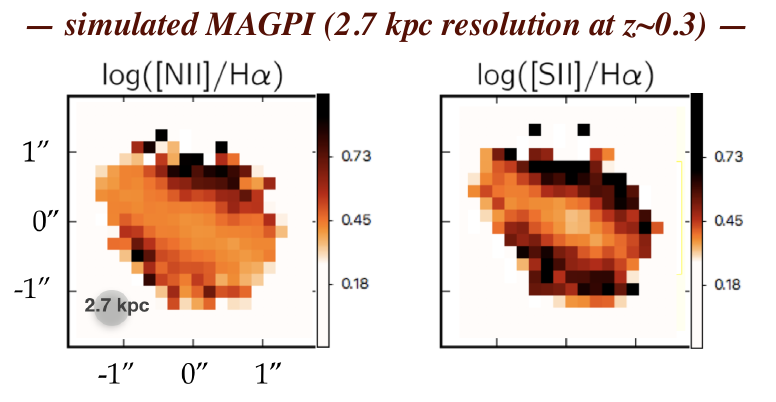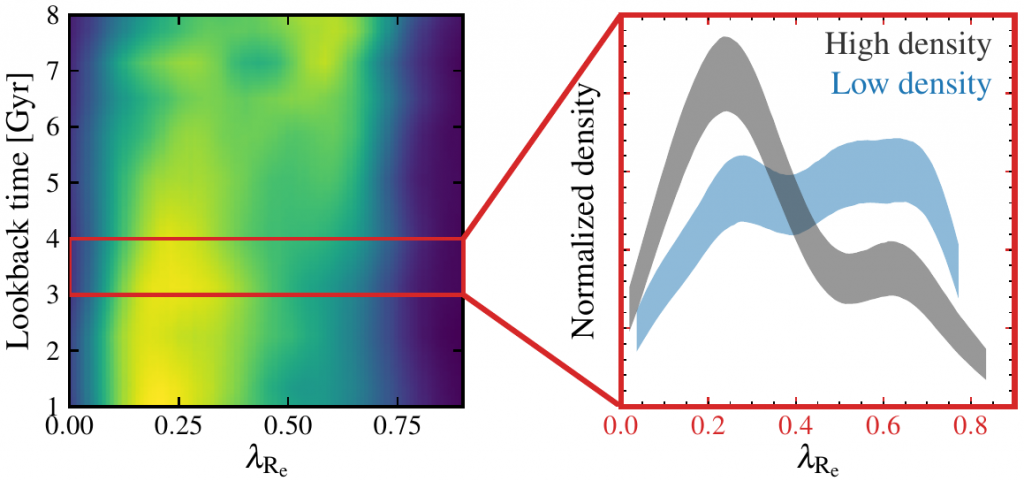About MAGPI
Why MAGPI?
Galaxies have undergone significant dynamical, morphological and chemical evolution over the past 8 billion years. It is predicted that environment is a key driver of this evolution 4 billion years ago (z~0.3), when simulations suggest there was the greatest diversity of evolutionary pathways between satellite and central galaxies. This critical epoch is beyond the reach of existing Integral Field
Spectroscopy (IFS) surveys. Current simultaneous 3D spectroscopy of stars and ionised gas has been limited to a short evolutionary window of 2 billion years look-back time. An important missing piece of the puzzle is how stars and ionised gas looked like in the progenitors of today’s galaxies.
Our goals
To dissect the evolutionary pathways that transformed the primarily disky/irregular systems at high redshift into today’s rich morphological mix of galaxies, it is essential to measure both the stars and ionised gas simultaneously in a range of environments. MAGPI will provide this information at this critical evolutionary stage, by greatly extending the limits of current IFS studies by a factor of 2 in look-back time and on approximately 60 massive central galaxies and their 118 satellite galaxies with resolved stellar and gas properties, with well characterised environments. MAGPI will allow us to distinguish nature from nurture and in combination with state-of-the-art theoretical models, our data will enable the next leap forward in our understanding of how galaxies evolve over cosmic time.
MAGPI galaxies
Key facts about our selected sample and available data
1
A complete sample of massive galaxies
MAGPI will observe approximately 60 massive galaxies selected purely based on their stellar mass at z~0.3 from the GAMA survey. Hence, our primary targets will include a mix of star-forming and passive galaxies.
2
Well characterised environments
MAGPI was selected from the GAMA survey, and hence we already have a good understanding of their environment, including Nth nearest neighbor densities and halo mass. Our observations will however allow us to refine those.
3
A large sample of satellite galaxies
In addition to the 60 main targets, we expect to observe 120 satellite galaxies around the primary targets, thanks to the large MUSE field-of-view. Our data will deliver excellent 3D spectroscopy of the ionised gas in these satellites.
Meet the principal investigators
MAGPI Science
MAGPI will map the detailed evolution of the stars and gas in galaxies in a range of halo masses 4 billion years ago with the main goal of revealing and understanding the physical processes responsible for the rapid transformation of galaxies in this epoch.
Discerning environmental impact on redistributing angular momentum
We will measure the dynamical properties for 60 central galaxies across halo mass at z~0.25-0.35. Halo mass estimates of all MAGPI galaxies will be robustly characterised using the resolved and serendipitous continuum sources within the MUSE field-of-view, allowing us to refine current estimates based on shallower spectroscopic data GAMA. To make the connection across epochs we will characterise galaxy dynamics using the specific angular momentum and stellar spin parameter observational proxy. In theoretical models specific angular momentum is fluid: it tends to increase slowly on average over time. However, it can either increase or decrease dramatically in individual systems during merger events depending on the total gas fraction. Measurements of these quantities therefore provide a snapshot of the overall dynamical state of galaxies that can be linked to their formation and assembly.
Fig. 1: The differing evolution of fast and slow rotators — Simulations show strong dynamical evolution of massive central galaxies iin the past 8 Gyrs, with environment maximally impacting this evolution 3-4 Gyrs ago, where MAGPI will be located. The figure shows the predictions for the EAGLE simulations. Higher probability density is shown with yellow and low probability density is shown with purple. The epoch probed by MAGPI is highlighted in red, also shown is a comparison of the stellar spin parameter distribution at high and low density environments. With the 60 MAGPI central galaxies we will be able to detect this or similar differences with 95 percent confidence.
A rich plethora of formation pathways can explain the observed combined distributions of the stellar spin parameter and apparent ellipticity. Simulations predict that the progenitors of today’s dispersion- and rotation-supported galaxies had indistinguishable kinematics at z~1 and diverged dramatically towards z=0; the timescale of the transition is slower in low halo mass environments such that the spin parameter distributions diverge maximally with halo mass at z~0.3 (Fig.1). Probing 60 massive central galaxies with deep observations at z~0.25-0.35 with MAGPI will either confirm or falsify these predictions with 95 percent confidence. We will determine the most common formation pathways for massive central galaxies by measuring the distributions of spin parameter in different environments and compare this distribution to that measured locally and expected from multiple simulations.
Understanding the role of accretion on assembly history
Repeated dynamical interactions can qualitatively reproduce the observed differences in morphology and spin parameter required to turn present-day spirals into early-type galaxies. Accretion of gas from either gas-rich mergers or external accretion can lead to the (re-)formation of a disc and overall spin-up of the system. Quantifying the interplay between galaxy mergers and gas accretion at the epoch where both processes are thought to be significant is critical to understanding morphological transformations. Asymmetries in kinematic maps, measured through kinemetry and requiring high-quality data, will reveal the assembly history of galaxies through signatures of past major mergers seen in stellar kinematic maps or recent accretion events seen in gas kinematic maps. In addition, for galaxies where both gas and stars are resolved (app. 100 galaxies expected in MAGPI), we will measure the stellar and gas kinematic misalignment, a tell-tale signature of recent gas accretion. Both stellar kinemetry and axis misalignments require stellar kinematic maps, a measurement not feasible at higher redshift. With MAGPI we will establish the role of mergers and gas accretion in transforming galaxies across halo mass and the evolution of such processes through comparison with present-day results.
Constraining energy sources and feedback activity
The transformation from star-forming to passive galaxies in different environments leaves distinct imprints on the inter-stellar medium (ISM). Resolved observations of the ISM are essential to determine the energy sources driving star formation and feedback, thus regulating the dynamical assembly of galaxies. With AO-aided observations, MAGPI will deliver high signal-to-noise emission line maps of star-forming galaxies out to ∼2 − 3Re with ∼2.7 kpc resolution. An example of expected spatially resolved emission line map variations is shown. The wealth of emission lines ([OII]λλ3727 to [SII]λλ6717, 31), available only below z = 0.38, will simultaneously trace active galactic nuclei (AGN) as well as resolved star formation and ISM properties such as metallicity, shock, ionisation parameters, and electron density. With these tools we will investigate the role of feedback driven processes (e.g. AGN; inside-out quenching) and external processes (e.g. ram pressure stripping; outside-in quenching) in producing the present-day passive galaxy population.


survey design
Our science goals require that we derive spatially-resolved stellar kinematic and structural properties for galaxies spanning a range of morphology, star-formation properties, and environment. Our state-of-the-art cosmological hydrodynamical simulations indicate that we require a minimum of 60 massive central galaxies spanning a range of host environments in order to detect the signatures of environment-dependent evolution at a 95 percent confidence level.
Our sample is therefore comprised of 60 central galaxies with stellar masses above 70 billion solar masses, 4 of which come from archival MUSE observations of the Abell 2744 (z ∼ 0.31) and Abell 370 (z ∼ 0.38) cluster fields, with the remaining 56 selected from the GAMA G12, G15, and G23 fields in the redshift range 0.25 < z < 0.35. The full sample spans a range of colour and environment (see Fig.), and the selected galaxies have continuum half-light sizes (Re) that will be well resolved by the MUSE+GALACSI point spread function (PSF) regardless of morphology.
Within the same field as our central targets we will derive resolved kinematic maps for an additional 118 satellite galaxies (shown as light blue symbols in the Fig.) with stellar masses above 10 billion solar masses, as well as integrated spectra for fainter and/or lower mass galaxies. These serendipitous galaxies are essential for a robust characterisation of the environment of each central target (refining the halo masses derived from GAMA with the spectroscopic completeness and depth of MAGPI). Additionally, resolved satellites will provide a sample with which to study the transformation of satellite galaxies through their gas and stellar kinematics, as well as interstellar medium properties.

